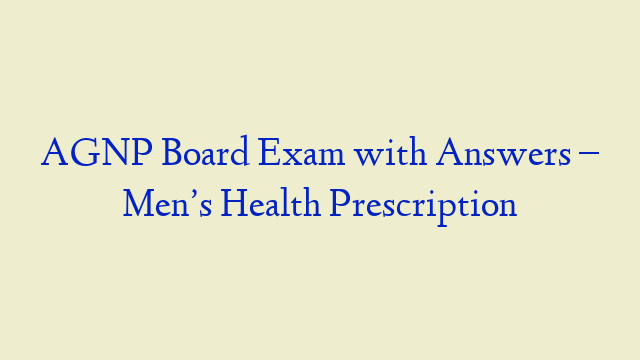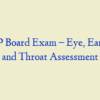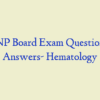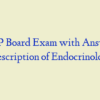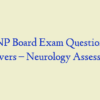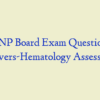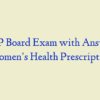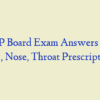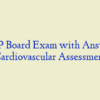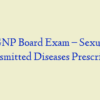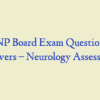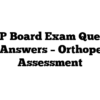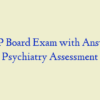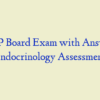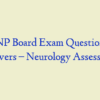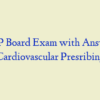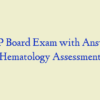Description
AGNP BOARD EXAM – Men’s Health Prescription (53 Questions and Answers)
- Levofloxacin (Levaquin), used to treat acute bacterial prostatitis, is a:
- Ciprofloxacin, used for the treatment of bacterial prostatitis, is a potent CYP1A2 inhibitor and is absolutely contraindicated with other CYP1A2 inhibitors. An example of another CYP1A2 inhibitor is:
- A 33-year-old man has been taking sulfamethoxazole/trimethoprim for the treatment of bacterial prostatitis. Brand names of this medication do NOT include:
- Patients with uncomplicated acute bacterial prostatitis who are NOT good candidates for treatment with a fluoroquinolone should take:
- PDE-5 inhibitors, such as tadalafil (Cialis) for the treatment of erectile dysfunction, should be avoided in patients with:
- The choice for initial treatment of acute bacterial prostatitis is:
- Patients who take sildenafil (Viagra) for the treatment of erectile dysfunction, should be instructed to avoid:
- To help with symptoms of chronic prostatitis, in addition to antibiotics, consider adjunctive therapy with an:
- Patients taking vardenafil (Levitra) should be advised to immediately report:
- Initial and routine monitoring for patients with benign prostatic hyperplasia (BPH) who are receiving tamsulosin (Flomax) should include:
- The recommended pharmacological treatment for phimosis in an adult man is a(n):
- Doxycycline (Doryx) is LEAST effective in the treatment of:
- PDE-5 inhibitors, such as vardenafil (Levitra), are indicate in the treatment of:
- Concomitant administration of sildenafil (Viagra) should be avoide with:
- A 65-year-old man who is receiving finasteride (Proscar) for benign prostatic hyperplasia (BPH) is exhibiting progressive symptoms. To reduce these symptoms, prescribe:
- 5-alpha reductase inhibitors are use in the treatment of:
- The recommend treatment for uncomplicated acute bacterial prostatitis caused by Neisseria gonorrhea is:
- A 20-year-old man with phimosis should be instructed to apply betamethasone (Sernivo) 0.05% cream at least twice daily for:
- Doxycycline (Doryx) is classified as a:
- A 58-year-old man is receiving dutasteride (Avodart) for benign prostatic hyperplasia (BPH). Avodart, a 5-alpha reductase inhibitor:
- Initial treatment of acute prostatitis should be guided by urinalysis and culture, and antibiotic therapy should be given for at least:
- Which of the follow is NOT a fluoroquinolone use to treat prostatitis?
- Fluoroquinolones use to treat prostatitis are NOT effective against:
- Patients who are on prolonged fluoroquinolones (i.e. ciprofloxacin) for the treatment of chronic prostatitis should be advise to immediately report:
- Sulfamethoxazole and trimethoprim (Bactrim), for the treatment of acute bacterial prostatitis, should NOT be prescribe for patients with:
- Ciprofloxacin (Cipro) is a broad spectrum:
- Due to the risk of severe hypotension, patients who are taking sildenafil (Viagra) should be advise to avoid:
- A 27-year-old man is be treat for epididymitis with doxycycline (Doryx). The patient should be advise that doxycycline may cause:
- Empiric antibiotic treatment of epididymitis in a 68-year-old man is:
- Finasteride (Proscar) is an:
- In the treatment of prostatitis, antibiotics that do NOT penetrate well into the prostate and seminal fluids include:
- A 60-year-old man who is treat with tamsulosin (Flomax) for benign prostatic hyperplasia (BPH) should NOT be treat concomitantly with:
- Which of the follow is a PDE-5 inhibitor indicate in the treatment of erectile dysfunction and benign prostatic hypertrophy?
- PDE-5 inhibitors, such as tadalafil (Cialis) for the treatment of erectile dysfunction, should be use with caution in patients who have:
- A 57-year-old man has chronic prostatitis with a causative organism that is resistant to fluoroquinolones. The patient has an allergy to sulfa drugs. The next best treatment option is:
- To avoid reducing the effectiveness of doxycycline (Doryx) for the treatment of epididymitis, it should not be taken concomitantly with:
- Patients receiving 5-alpha-reductase inhibitors should see maximum efficacy at approximately:
- A 65-year-old man with benign prostatic hyperplasia (BPH) is treat with tamsulosin (Flomax). Potential side effects are:
- A 55-year-old man with benign prostatic hypertrophy has overflow incontinence. The first-line treatment is:
- Suppressive antibiotic therapy for chronic bacterial prostatitis is:
- To avoid esophageal irritation, patients taking doxycycline (Doryx) for the treatment of epididymitis should be advise to:
- Which of the follow is an alpha 1 adrenergic antagonist use to treat benign prostatic hyperplasia?
- Doxazosin (Cardura) is an alpha adrenergic antagonist. Oxybutynin (Ditropan), Tolterodine (Detrol) and Solifenacin (Vesicare) are all classified as anticholinergic agents.
- Treatment of chronic prostatitis may require prolonged antibiotic regimens, up to:
- A 45-year-old man is receive finasteride (Proscar) for the symptomatic treatment of benign prostatic hyperplasia. The patient should be advise that:
- A 24-year-old man patient treated for epididymitis cause by Neisseria gonorrhoeae should be advised that:
- A common side effect associate with sildenafil (Viagra) is:
- Alpha-adrenergic antagonists for the treatment of benign prostatic hyperplasia (BPH):
- The generic name for Levitra is:
- Patients take tamsulosin (Flomax) should be advise to seek immediate medical attention for:
- Concomitant administration of sildenafil (Viagra) and tamsulosin (Flomax) may result in:
- The brand name for sildenafil is:
- Empiric treatment of epididymitis in a 28-year-old sexually active man is:
- Trimethoprim-sulfamethoxazole (Bactrim DS) for the treatment of acute bacterial prostatitis is NOT effective against:
- Check out our latest courses on PSYC 502 Week 3.
